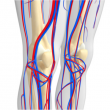Paclitaxel coated balloons in peripheral territory have been under the spotlight for alleged increased mortality, which even though not observed in this study, experts insist, calls for new studies with enough statistical power. Compared against plain balloon angioplasty, paclitaxel coated balloons resulted in improved patency and less revascularization at 24 months in superficial or popliteal...
The Most Relevant Articles of 2018 in Peripheral Vascular Disease
1- What’s New in the European Guidelines on Peripheral Arterial Disease Since the last version of the European guidelines on the diagnosis and treatment of peripheral arterial disease in 2011, there have been many trials and registries that warrant guideline adjustments in many aspects. The first novelty is the teamwork that gave way to these...
Clinical Utility of CT-Derived FFR for Decision-Making
In this large international multicenter population, computed-tomography (CT)-derived fractional flow reserve (FFR) modified treatment recommendation in two-thirds of subjects compared with CT angiography alone, and it was associated with less negative invasive angiographies. It also predicted revascularization and identified low-risk patients. A non-invasive means to know the anatomy and function of patients with stable chronic...
Cautious Administration of Supplemental 02, Especially in Acute Stroke or MI
Recent studies show the potential damaging effect of supplemental oxygen in the context of acute stroke and myocardial infarction. Experts now say that it should not be used in patients with >92% oxygen saturation. These guidelines have looked into the most recent studies, including the DET02X-AMI, which suggest supplemental oxygen therapy could increase mortality in...
Safety of Combining New Anticoagulant Agents and Dual Antiplatelet Therapy
Atrial fibrillation is the most common arrhythmia and its combination with a history of acute myocardial infarction or coronary angioplasty is quite frequent. According to this study (recently published in JACC), in a real-world population, the combination of direct anticoagulant agents and dual antiplatelet therapy reduces significantly the risk of bleeding and provides similar thromboembolic...
Mortality in Peripheral Vascular Disease Drops Due to Revascularization
This cohort study shows that, from 2006 to 2015, the overall survival rate increased and the risk of major amputation decreased following lower limb revascularization. These population observations indicate that outcomes after lower limb revascularization have improved during the assessed period, and so have the centralization and specialization of interventional services. The availability and diversity...
Surgery Seems Superior to Angioplasty in Young Patients
Long-term follow-up of patients under 50 with multivessel coronary artery disease suggests surgery outcomes are significantly better than angioplasty outcomes. This study, presented at the Society of Thoracic Surgeons’ (STS) Annual Meeting, concludes that surgery should continue as plan A when it comes to young patients with three-vessel disease. Surgeons complain that many patients never actually...
It is justified to use distal protection filter in venous bridges?
The current guidelines point out a class I recommendation to the use of distal embolic protection devices for angioplasty in venous bridges, in fact, the evidence is controversial to support this recommendation. The goal of this meta-analysis was to compare mortality from any cause, major cardiovascular events, acute myocardial infarction, and target vessel revascularization of...
New Strategies for the Femoropopliteal Artery
Courtesy of Dr. Carlos Fava. The incidence of peripheral vascular disease is clearly increasing, progressing towards critical ischemic claudication and amputation. Angioplasty is currently the treatment of choice for these pathologies. Several times, an implanted stent ends up cracking due to extensive calcification, increasing the rate of restenosis and worsening critical ischemia. Technological development on drug-eluting...
Promising outcomes for DEB in long femoropopliteal artery lesions
Courtesy of Dr. Carlos Fava. For type A and B femoropopliteal artery lesions, percutaneous transluminal angioplasty (PTA) with balloon has proven beneficial; however, drug-eluting balloons (DEB) have shown superiority as regards restenosis. Some studies have reported favorable outcomes for DEB in type C and D lesions, but its real benefit is still unclear. This study prospectively...









